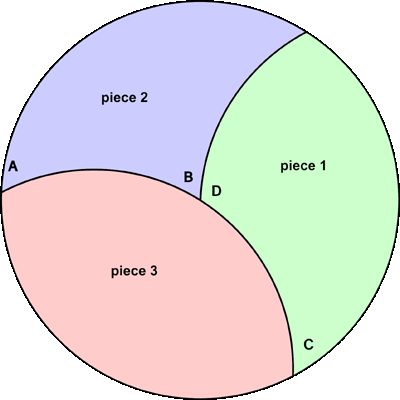 |
Three Piece Circle Puzzle |
 |
 |
Three Piece Circle Puzzle |
 |
This material can be used in kindergarten and also in middle schools.
![]() Supplies:
Supplies:
| Compass |  |
|
| scissors | ||
| 5 x 8 index card |
Figure to be constructed and dissected
 |
Basic task.
 |
|
Picture 1
|
Show students the model pieces (see figure to be constructed and dissected above), and instruct them about how to use a compass to draw a large circle on an index card and dissect it into the three pieces shown in picture 1.
Activities for the early grades.
(1) Arrange the pieces into a circle.
(2) Arrange the pieces into an interesting configuration. (Make up your own rules about which configurations are acceptable.) Fasten the configurations together with Scotch tape and display them.
Remark.
There are so many configurations that each student in a typical class can find something different.
Higher grades activities.
(1) Find the perimeter of each piece.
A solution.
(2) Find the area of each piece.
A solution.
 |
|
Picture 2
|
Look at picture 2. It shows you (by cutting and pasting) that piece 1 is 1/3 of the whole circle,
1/3* ![]() *(radius)2, and that piece 2 has the area of two equilateral triangles with sides equal to the radius of the circle. This yields,
*(radius)2, and that piece 2 has the area of two equilateral triangles with sides equal to the radius of the circle. This yields,
The area of piece 1 = 1/3*
*r2
The area of piece 2 =
3/2*r2
The area of piece 3 =
*r2 - the previous two.
Substitute the value for r and compute the areas. Do not forget to name the units.
(3) Find the angles in the corners of each piece.
A solution.
The key concept is that the angle between two curved lines is the angle between straight lines tangent to them at the point of their intersection. (See picture 3.)
 |
|
Picture 3
|
Comparing picture 3 to pictures 2 and 1, derive the conclusion that
A = B = 60°
C = D = 120°